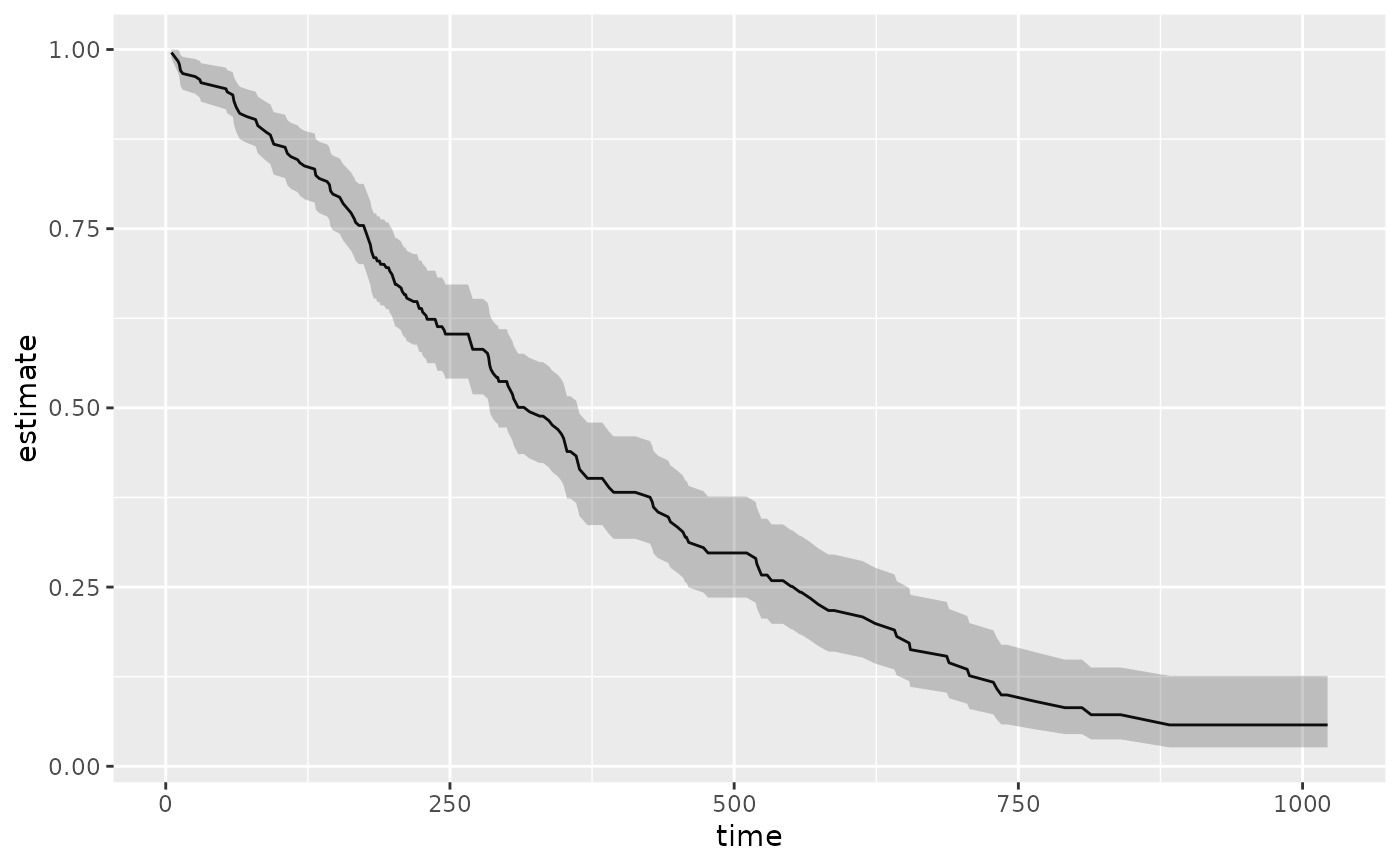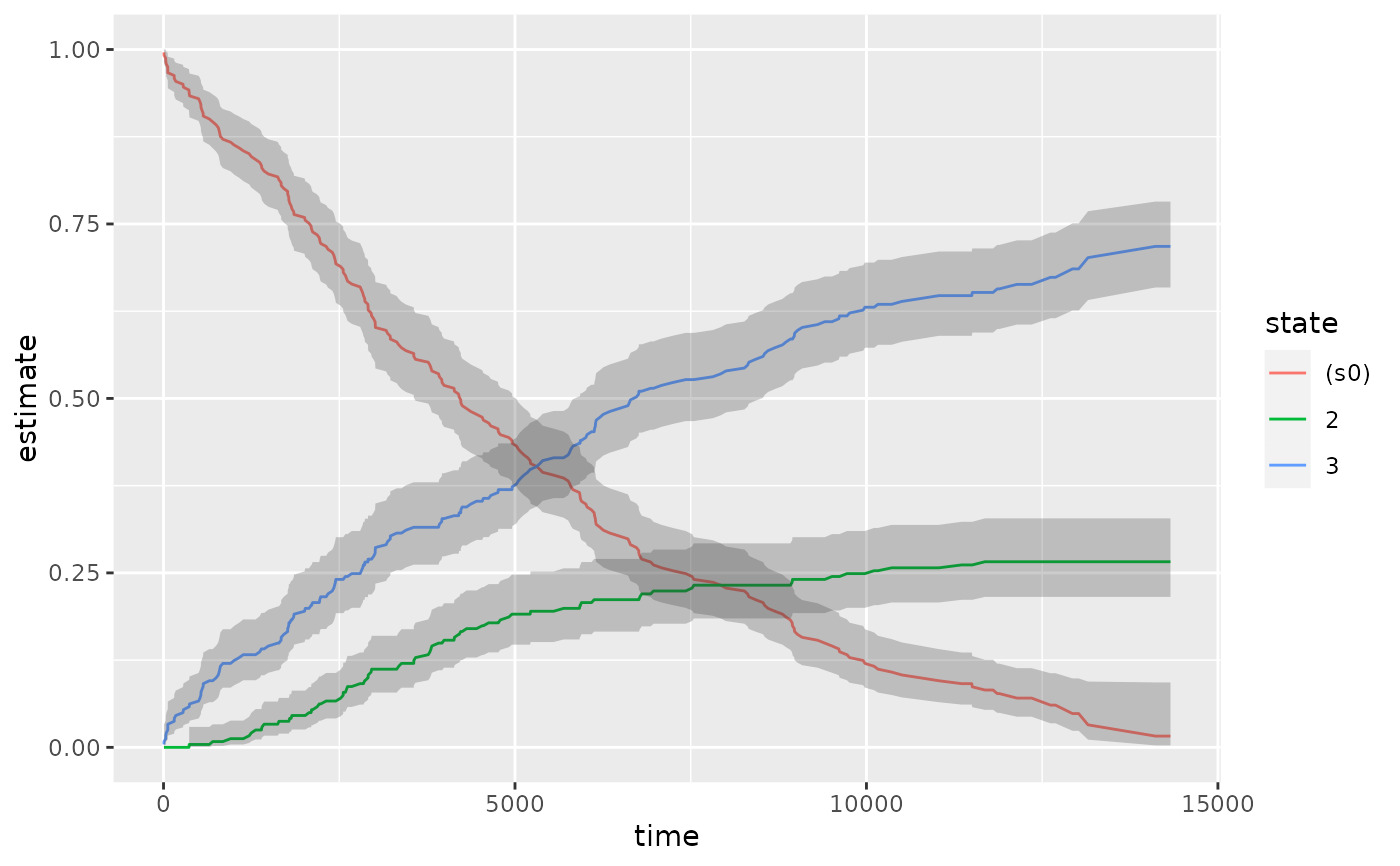Tidy 總結了有關模型組件的信息。模型組件可能是回歸中的單個項、單個假設、聚類或類。 tidy 所認為的模型組件的確切含義因模型而異,但通常是不言而喻的。如果模型具有多種不同類型的組件,您將需要指定要返回哪些組件。
參數
- x
-
從
survival::survfit()返回的survfit對象。 - ...
-
附加參數。不曾用過。僅需要匹配通用簽名。注意:拚寫錯誤的參數將被吸收到
...中,並被忽略。如果拚寫錯誤的參數有默認值,則將使用默認值。例如,如果您傳遞conf.lvel = 0.9,所有計算將使用conf.level = 0.95進行。這裏有兩個異常:
也可以看看
其他生存整理器:augment.coxph() , augment.survreg() , glance.aareg() , glance.cch() , glance.coxph() , glance.pyears() , glance.survdiff() , glance.survexp() , glance.survfit() , glance.survreg() , tidy.aareg() , tidy.cch() , tidy.coxph() , tidy.pyears() , tidy.survdiff() , tidy.survexp() , tidy.survreg()
值
帶有列的 tibble::tibble():
- conf.high
-
估計置信區間的上限。
- conf.low
-
估計置信區間的下限。
- n.censor
-
審查事件的數量。
- n.event
-
時間 t 時的事件數。
- n.risk
-
零時刻處於危險中的人數。
- std.error
-
回歸項的標準誤差。
- time
-
時間點。
- estimate
-
多狀態時生存率或累積發病率的估計
- state
-
狀態是否為多狀態 survfit 對象輸入
- strata
-
strata if 分層 survfit 對象輸入
例子
# load libraries for models and data
library(survival)
# fit model
cfit <- coxph(Surv(time, status) ~ age + sex, lung)
sfit <- survfit(cfit)
# summarize model fit with tidiers + visualization
tidy(sfit)
#> # A tibble: 186 × 8
#> time n.risk n.event n.censor estimate std.error conf.high conf.low
#> <dbl> <dbl> <dbl> <dbl> <dbl> <dbl> <dbl> <dbl>
#> 1 5 228 1 0 0.996 0.00419 1 0.988
#> 2 11 227 3 0 0.983 0.00845 1.00 0.967
#> 3 12 224 1 0 0.979 0.00947 0.997 0.961
#> 4 13 223 2 0 0.971 0.0113 0.992 0.949
#> 5 15 221 1 0 0.966 0.0121 0.990 0.944
#> 6 26 220 1 0 0.962 0.0129 0.987 0.938
#> 7 30 219 1 0 0.958 0.0136 0.984 0.933
#> 8 31 218 1 0 0.954 0.0143 0.981 0.927
#> 9 53 217 2 0 0.945 0.0157 0.975 0.917
#> 10 54 215 1 0 0.941 0.0163 0.972 0.911
#> # ℹ 176 more rows
glance(sfit)
#> # A tibble: 1 × 10
#> records n.max n.start events rmean rmean.std.error median conf.low
#> <dbl> <dbl> <dbl> <dbl> <dbl> <dbl> <dbl> <dbl>
#> 1 228 228 228 165 381. 20.3 320 285
#> # ℹ 2 more variables: conf.high <dbl>, nobs <int>
library(ggplot2)
ggplot(tidy(sfit), aes(time, estimate)) +
geom_line() +
geom_ribbon(aes(ymin = conf.low, ymax = conf.high), alpha = .25)
 # multi-state
fitCI <- survfit(Surv(stop, status * as.numeric(event), type = "mstate") ~ 1,
data = mgus1, subset = (start == 0)
)
td_multi <- tidy(fitCI)
td_multi
#> # A tibble: 711 × 9
#> time n.risk n.event n.censor estimate std.error conf.high conf.low
#> <dbl> <int> <int> <int> <dbl> <dbl> <dbl> <dbl>
#> 1 6 241 0 0 0.996 0.00414 1 0.988
#> 2 7 240 0 0 0.992 0.00584 1 0.980
#> 3 31 239 0 0 0.988 0.00714 1 0.974
#> 4 32 238 0 0 0.983 0.00823 1.00 0.967
#> 5 39 237 0 0 0.979 0.00918 0.997 0.961
#> 6 60 236 0 0 0.975 0.0100 0.995 0.956
#> 7 61 235 0 0 0.967 0.0115 0.990 0.944
#> 8 152 233 0 0 0.963 0.0122 0.987 0.939
#> 9 153 232 0 0 0.959 0.0128 0.984 0.934
#> 10 174 231 0 0 0.954 0.0134 0.981 0.928
#> # ℹ 701 more rows
#> # ℹ 1 more variable: state <chr>
ggplot(td_multi, aes(time, estimate, group = state)) +
geom_line(aes(color = state)) +
geom_ribbon(aes(ymin = conf.low, ymax = conf.high), alpha = .25)
# multi-state
fitCI <- survfit(Surv(stop, status * as.numeric(event), type = "mstate") ~ 1,
data = mgus1, subset = (start == 0)
)
td_multi <- tidy(fitCI)
td_multi
#> # A tibble: 711 × 9
#> time n.risk n.event n.censor estimate std.error conf.high conf.low
#> <dbl> <int> <int> <int> <dbl> <dbl> <dbl> <dbl>
#> 1 6 241 0 0 0.996 0.00414 1 0.988
#> 2 7 240 0 0 0.992 0.00584 1 0.980
#> 3 31 239 0 0 0.988 0.00714 1 0.974
#> 4 32 238 0 0 0.983 0.00823 1.00 0.967
#> 5 39 237 0 0 0.979 0.00918 0.997 0.961
#> 6 60 236 0 0 0.975 0.0100 0.995 0.956
#> 7 61 235 0 0 0.967 0.0115 0.990 0.944
#> 8 152 233 0 0 0.963 0.0122 0.987 0.939
#> 9 153 232 0 0 0.959 0.0128 0.984 0.934
#> 10 174 231 0 0 0.954 0.0134 0.981 0.928
#> # ℹ 701 more rows
#> # ℹ 1 more variable: state <chr>
ggplot(td_multi, aes(time, estimate, group = state)) +
geom_line(aes(color = state)) +
geom_ribbon(aes(ymin = conf.low, ymax = conf.high), alpha = .25)

相關用法
- R broom tidy.survreg 整理 a(n) survreg 對象
- R broom tidy.survexp 整理 a(n) survexp 對象
- R broom tidy.survdiff 整理 a(n) survdiff 對象
- R broom tidy.summary_emm 整理一個(n)summary_emm對象
- R broom tidy.summary.glht 整理一個(n)summary.glht對象
- R broom tidy.summary.lm 整理 a(n)summary.lm 對象
- R broom tidy.svyolr 整理 a(n) svyolr 對象
- R broom tidy.spec 整理一個(n)規範對象
- R broom tidy.sarlm 空間自回歸模型的整理方法
- R broom tidy.speedglm 整理 a(n) speedglm 對象
- R broom tidy.speedlm 整理 a(n) speedlm 對象
- R broom tidy.systemfit 整理 a(n) systemfit 對象
- R broom tidy.robustbase.glmrob 整理 a(n) glmrob 對象
- R broom tidy.acf 整理 a(n) acf 對象
- R broom tidy.robustbase.lmrob 整理 a(n) lmrob 對象
- R broom tidy.biglm 整理 a(n) biglm 對象
- R broom tidy.garch 整理 a(n) garch 對象
- R broom tidy.rq 整理 a(n) rq 對象
- R broom tidy.kmeans 整理 a(n) kmeans 對象
- R broom tidy.betamfx 整理 a(n) betamfx 對象
- R broom tidy.anova 整理 a(n) anova 對象
- R broom tidy.btergm 整理 a(n) btergm 對象
- R broom tidy.cv.glmnet 整理 a(n) cv.glmnet 對象
- R broom tidy.roc 整理 a(n) roc 對象
- R broom tidy.poLCA 整理 a(n) poLCA 對象
注:本文由純淨天空篩選整理自等大神的英文原創作品 Tidy a(n) survfit object。非經特殊聲明,原始代碼版權歸原作者所有,本譯文未經允許或授權,請勿轉載或複製。
